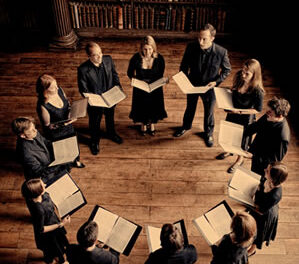It is refreshing in these days of media blitzes to come across an artist who refuses to let anything but his art speak for him. The name of American composer Paul Schoenfield is infrequently heard, but his large musical output has been performed and recorded by major orchestras here and abroad. Two local musicians, cellist Fred Raimi and violinist Richard Luby, who knew Schoenfield as students at the same Detroit high school, invited him to come here for a concert of his music performed by the Mallarmé Chamber players sponsored by the Freeman Center for Jewish life at Duke University. Luby and Raimi were joined by violist Jonathan Bagg, violinist Hsiao-mei Ku and pianist Jane Hawkins.
In a pre-concert Q & A session, Schoenfield, 54, came across as mild mannered and self-effacing. He was reluctant to discuss his own music but talked freely about his family background and influences in his life, making wry observation on the musical scene in the twentieth century.
Schoenfield marches and composes to his own drummer, eschewing intellectual and musical fashion, notably the doctrinaire serialism foisted upon all would-be composers of his vintage. In fact, the narrowness of academic composition departments has caused him to shy away from the university appointments that enable most American composers to put bread on the table. One of Schoenfield’s favorite twentieth century composers is Shostakovich, a preference which, if admitted openly, probably would have gotten him pitched out of any graduate composition department of the 60s and 70s.
The concert opened with Six British Folk Songs for cello and piano, composed in 1985 on commission for cellist Laura Sewell as a tribute to Jacqueline DuPré. Schoenfield selected from an anthology six relatively unknown folksongs, creating freely structured fantasies on each of the melodies, including some motivic elements common to all six movements. Although we had only the titles of the songs and a brief synopsis of the content to go on, it was clear that the central drama of each song dictated the musical setting. Once having had to make a career choice between mathematics and music, Schoenfield apparently couldn’t help incorporating a quasi-mathematical organizing principle into his suite: the odd numbered movements increased in tempo while the even numbered ones decreased in tempo. Raimi and Hawkins clearly had fun performing these delightful pieces.
In 1996 a former MGM executive commissioned a composition from Schoenfield. The composer asked him to name his favorite song from the MGM repertory, which turned out to be “Carolina in the Morning.” The result, Carolina Reveille for piano quartet, uses bits of the song in a set of free variations of increasing liveliness, complexity and tempo. Only in the penultimate variation do we hear the theme played in its entirety. Luby, Bagg, Raimi and Hawkins got into the spirit of this tour de force which should make a welcome addition to the meager piano quartet repertoire.
Schoenfield revealed the influence of his Russian idol in the final work on the program, Tales from Chelm for string quartet. Chelm, the fictitious Jewish “Town of fools” in Poland, is the source of endless humorous tales in which the town’s wise men specialize in finding convoluted solutions to simple problems. The four movements, “The Wise Men of Chelm, “A Ballet Dancer,” “The Witch Cunigunde” (who is in love with a rabbi) and never-victorious “Armies of Chelm” incorporate a number of Hasidic folk tunes. Here one sees the distinct influence of Shostakovich in both harmonic style and in the way the folk melodies are presented. Unlike the tormented Shostakovich, however, Schoenfield creates an appropriately humorous and ironic a mood throughout the entire quartet.
Although having someone actually read the stories before each movement would have truly been a class act, Raimi at least summarized them for the audience. For example, the first movement, “The Wise Men of Chelm,” illustrates a tale in which the people of Chelm, in digging a foundation for a new synagogue, can’t figure out what to do with the mound of dirt from the hole. With their typically convoluted reasoning, portrayed by ever-increasing musical chaos, the wise men first advise the townspeople to dig another hole for the leftover dirt. When this solution produces a second pile, the wise men finally advise the Chelmites to dig yet another hole, but to be sure to make it twice as large.
Once again – we never tire of saying it – Mallarmé has produced another innovative program that expands our musical horizons.












